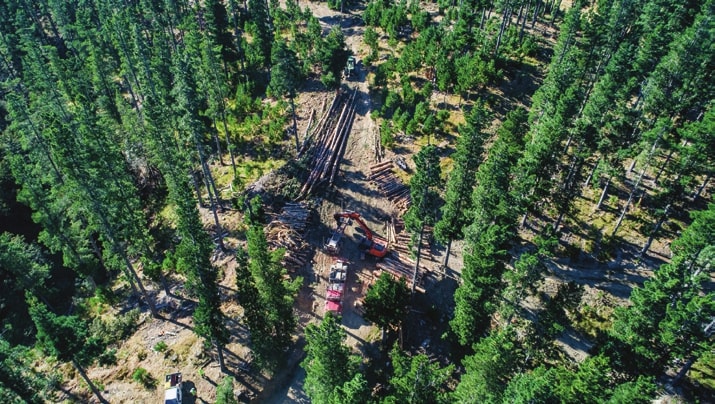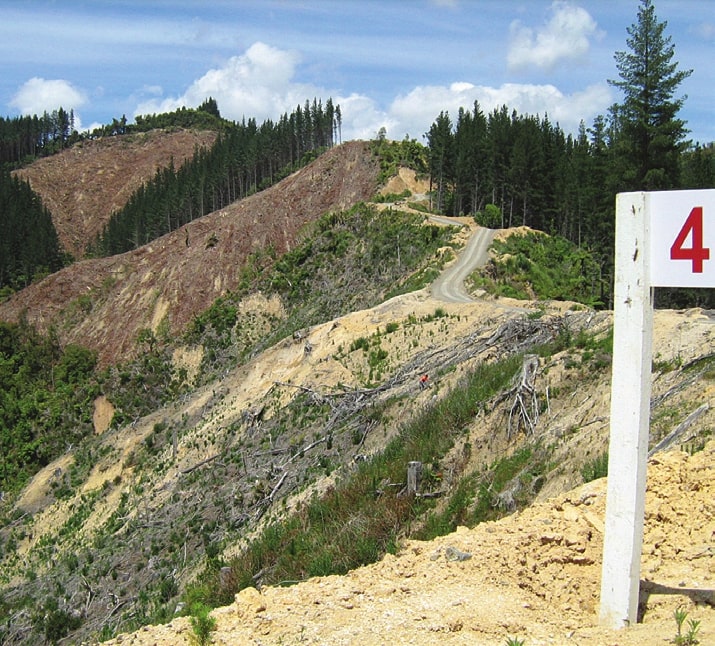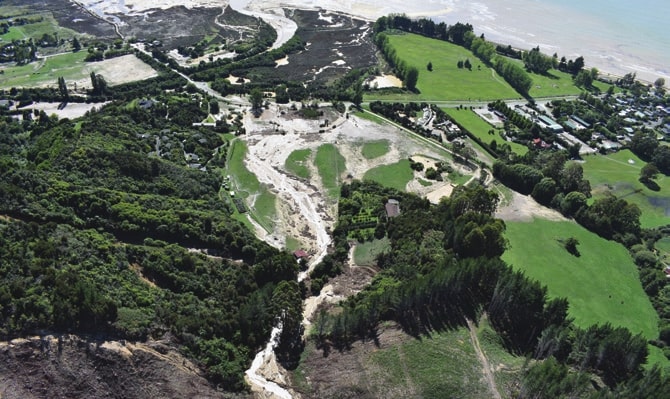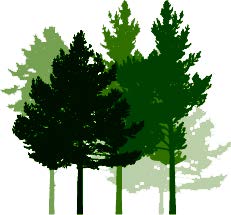Why alternatives to clear felling harvests should be seriously considered
Mark Bloomberg, New Zealand Tree Grower May 2021.
New Zealand currently harvests about 37 million cubic metres of logs a year. About 99 per cent of this harvest volume is from clear felling harvests, with approximately one per cent coming from production thinning or other harvesting systems which do not involve clear felling. Such complete dominance of clear fell harvesting is no accident. Compared with other forest harvesting methods, clear felling is almost always cheaper and easier to manage in terms of the harvest, as well as in terms of subsequent site preparation and forest re-establishment.
What is clear felling?
Clear felling is defined as cutting down and extracting all, or nearly all, of the trees on an area more than a quarter of a hectare. At the other extreme, clear felling can be extended over hundreds of hectares of contiguous harvested area as shown in the photograph below which shows a large clear felling coup in the Bay of Plenty.
The alternative is shown in the photograph above of a radiata pine forest managed under a selection system at Woodside Forest, North Canterbury. Note the range of tree sizes growing within a one-hectare area.
In general, alternatives to clear fell harvesting are more complex, and this complexity is reflected in the classification and terminology applied to these alternatives. The novice forester encounters terms such as shelterwood, group selection, single-tree selection, continuous cover forestry, target-diameter harvesting, plenterwald, femelschlag, dauerwald and so on. However, all this can be boiled down to how many crop trees are retained on the site after harvesting, and where they are.
- If under 10 per cent of crop trees are retained, the harvest system is clear felling, possibly with some trees retained as seed sources or because they are protected as high conservation value trees.
- If over 70 per cent of the crop trees are retained, the harvest system is a selection system, with only individual trees or small groups of trees harvested and the forest left more-or-less intact after harvesting.
- If between 10 per cent and 70 per cent of the crop trees are retained, the harvest system is a retention system. Trees may be retained as individuals or else in intact groups of trees, dispersed over the coup in some pre-determined pattern.


Why not clear fell?
Alternatives to clear felling involve retaining at least 10 per cent of the crop trees after harvest. The next and obvious question to ask is why retain trees when removing them all is cheaper and easier. There are several reasons for using retention or selection harvest systems. Overseas and in our indigenous forests, one of the main reasons for alternative harvesting systems is the need to retain forest ecosystem services after harvesting. Examples of such forest ecosystem services include −
- The protection which a forest provides against soil erosion. This protection is reduced by clear felling, and a recent world-wide review found that soil erosion rates on clear fell harvest sites were between two and 10 times greater than for intact forest, even with best-practice harvesting.
- Forests have bio-geochemical networks which efficiently cycle soil nutrients with minimal losses to leaching. After clear felling, the forest becomes ‘leaky’ with a much higher level of nutrient leaching until a new canopy and root network is established.
- Forests are the most biodiverse terrestrial ecosystems on the globe. After clear felling, organisms which depend on forest habitats may be lost to the site, even if temporarily. Loss of nesting sites, food sources, cover, shade and protection from climate extremes will all have an effect
- Forests have amenity values − aesthetic, recreational, spiritual and cultural.
Retaining ecosystem services
A possible reason for adopting alternative harvesting systems is to retain the forest’s ecosystem services after harvesting. This may be voluntarily accepted by some forest owners but I suspect they will be a small minority. The forest industry is set up around the clear felling regime, and it is not easy to escape this.
If alternatives to clear felling of planted forests are adopted in New Zealand, it is more likely that this will be due to societal pressure − whether informal pressure such as through the media, or formal pressure by regulatory or other legal means. It seems to me likely that this will be driven by the need to maintain soil and water services, rather than amenity or biodiversity. This is because the loss of soil and water services after clear felling has become increasingly controversial in New Zealand.
Clear felling on steep erosion-prone lands has frequently resulted in landslide debris and logging slash affecting built and natural environments downstream of the harvesting site. Over the last 10 years, prosecutions of forest companies for illegal discharges of erosion debris and logging slash into waterways are now into double figures, with fines now totalling more than a million dollars. In other cases, landslides from forestry clearfell sites have dramatically affected downstream land owners, yet regulators have declined to prosecute because the landslides have originated from operations where harvesting complied with the Resource Management Act. Regulators have had their share of criticism from the community for this, even though there is no legal basis for prosecution.

The photograph above shows sediment from a large clear fell site which has lowed through a rural-residential zone until it has reached a coastal wetland and then the coastline. The felling complied with the Resource Management Act and there was no legal action taken against the forest owner or manager.
Unless New Zealand forest owners stop large-coup clear felling on erosion-susceptible land, the incidence of landslides from clear felling is not going to abate.
About 25 per cent of our planted forests are on erosion-susceptible land, so there is plenty of scope for such landslides. Possibly this problem could be solved by forest owners voluntarily adopting alternative harvesting practices for erosion-susceptible land − or even voluntarily not harvesting on some land.
However, at the time of writing, I do not see forest owners moving far enough or fast enough. The risk is that eventually, pressure from society will become overwhelming and we will see very strong regulation which will require alternatives to large-scale clear felling on erosion-susceptible lands. It will be on society’s terms, not those of forest owners.
Mark Bloomberg is Adjunct Senior Fellow at Te Kura Ngahere | School of Forestry, University of Canterbury. Some photographs by Ryan McDonald and Glenn Stevens.

 Farm Forestry New Zealand
Farm Forestry New Zealand